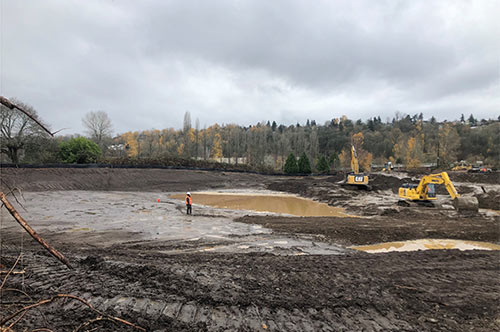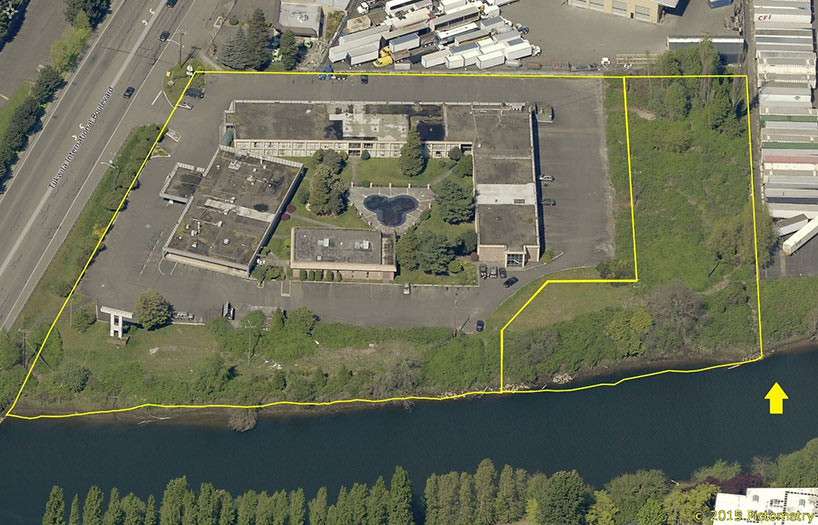Chinook Wind Mitigation Project

Project description
The Chinook Wind Mitigation Project is located on 5.912 acres at river mile 6.7 on the north bank of the Duwamish River in the City of Tukwila. Construction began in 2021 and the completed project created more than 4 acres of new estuarine wetland, aquatic, and riparian habitat area. The project includes off-channel aquatic and intertidal mud flat habitat, as well as low and high marsh, and riparian habitat. Chinook Wind is downstream from the City of Tukwila’s Duwamish Gardens Shoreline Restoration project and together the sites provide critical, rare, off-channel and shallow-water edge habitat for Chinook and other salmon.
The Chinook Wind Mitigation Project will provide immensely important habitat in the Green Duwamish system: transition zone rearing and refuge habitat for endangered Chinook salmon, which in turn are a primary food source for endangered orca whales. The Chinook Wind Mitigation Project is important for species recovery and watershed function because there are no remaining naturally occurring estuarine wetlands of this size in the Duwamish River system, due to many decades of urbanization and intensive industrial uses in the Duwamish River valley.
The Chinook Wind Mitigation Project will compensate for unavoidable permitted impacts to wetlands and aquatic resources in Water Resource Inventory Area (WRIA) 9.

Background
97% of the estuarine wetland habitat in the Duwamish River has been lost in the last 150 years (WRIA 9 Salmon Habitat Plan 2005). Land along the densely-developed Duwamish River is expensive and seldom available for purchase. The Chinook Wind site represented a rare opportunity to acquire, restore, and permanently protect a large area in the transition zone, where fresh and salt water mix. The project will create significant and valuable off-channel habitat where juvenile salmon can reside while adjusting from fresh water to salt water as they feed and grow.
King County purchased the Chinook Wind property in 2015 and hired a contractor to remove buildings and impervious surfaces, including asbestos and other hazardous materials, from the site. Impervious surface removal was completed in 2016 and a small-scale soil contamination clean-up was completed in 2020. Final design of the Chinook Wind Mitigation Project was completed in early 2021 and construction begins in the summer of 2021.
Vicinity map

Project design
The Chinook Wind Mitigation Project will provide sheltered off-channel habitat surrounded by mudflat, low marsh, high marsh, and riparian habitats. This project offers an extraordinary opportunity to provide a rare resource that is immensely important for Endangered Species Act listed (ESA-listed) juvenile Chinook salmon. Persistently inundated aquatic habitat represents extremely limited and critically important habitat for ESA-listed juvenile Chinook. Once common in the Duwamish, marshes are now extremely rare. When adjacent to mudflat and aquatic habitat, marshes provide valuable sources of food for juvenile Chinook. In addition to designing the Chinook Wind Mitigation Project to provide the ideal habitat for the location, the site is designed to be accessible to juvenile salmon virtually 100% of the time. Excavation elevations are at a level (El. -2 NAVD88) that will allow juvenile salmon to rest and feed within the Chinook Wind Mitigation Project even at the lowest tides. This unique feature is designed to provide shelter for juvenile salmon during extreme low tides when they would typically be forced to move to deeper water and be flushed downriver.


Mitigation project milestones
Mitigation project construction






Demolition





Project schedule
Chinook Wind Mitigation Project schedule overview
| Acquisition & Impervious Surface Removal | |
|---|---|
|
Property Acquired |
August 2015 |
|
Contractor removed existing buildings and impervious surfaces |
May 2016 |
| Restoration of Shoreline | |
|---|---|
|
Alternatives analysis complete |
August 2018 |
|
30% design plans complete |
January 2019 |
|
60% design plans complete |
March 2020 |
|
90% design plans complete |
July 2020 |
|
Implementation |
July 2021 - February 2023 |
|
Monitoring |
April 2023 - April 2032 |

 Translate
Translate